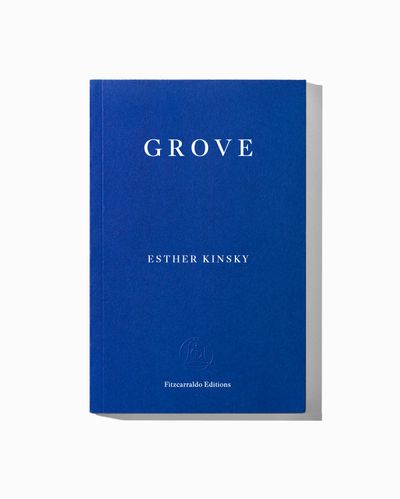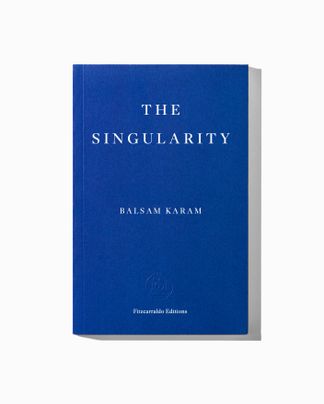An unnamed narrator, recently bereaved, travels to Olevano, a small village south-east of Rome. It is winter, and from her temporary residence on a hill between village and cemetery, she embarks on walks and outings, exploring the banal and the sublime with equal dedication and intensity. Seeing, describing, naming the world around her is her way of redefining her place within it. Written in a rich and poetic style, Grove is an exquisite novel of grief, love and landscapes.

Grove
Translated by Caroline Schmidt
French paperback with flaps, 280 pages
Published 15 April 2020
Grove
Translated by Caroline Schmidt
TERRAIN
In Olevano Romano I’m staying for a time in a house on a hill. When approaching town on the winding road that leads up from the plain, the building is recognizable in the distance. To the left of the hill with the house is the old village, vaulting the steep slope. It is the colour of cliffs, a different shade of grey in every light and weather. To the right of the house, somewhat farther uphill, is the cemetery – angular, whitish cement-grey, surrounded by tall, slender black trees. Cypresses. Sempervirens, the everlasting tree of death; a defiant answer to the unexacting pines, projected sharply into the sky.
I walk along the cemetery wall until the road forks. To the southeast it leads through olive groves, becomes a dirt road between a bamboo thicket and vineyards, and grazes a sparse birch grove. Three or four birch trees, scattered messengers, vagrants among olive trees, holm oaks and vines, stand at a slant on a kind of protuberance, which rises up beside the path. From this protuberance one looks to the hill with the house. The village lies once again on the left, the cemetery on the right. A small car moves through the village lanes, while someone hangs laundry on a line beneath the windows. The laundry says: vii.
In the nineteenth century, this protuberance might have served as a good lookout point for those who came here to paint. Perhaps the painters, pulling their handkerchiefs from their jacket pockets, carelessly and unwittingly scattered birch seeds brought from their northern-coloured homelands. A birch blossom, picked in passing and long forgotten, spread rootlets here between blades of grass. The painters would have wiped the sweat from their brows and continued painting. The mountains, the village, perhaps the small columns of smoke rising above the plain as well. Where was the cemetery then? The oldest grave that I can find in the cemetery belongs to a German from Berlin, who died here in 1892. The second-oldest grave is for a man with a bold expression and a hat, of Olevano, born in 1843, died in 1912.
Below the vagrant birch trees, a man works in his vineyard. He cuts bamboo, trims the stalks, burns off the ragged wisps, brings the lengths of the stalks into line. He’s building scaffolding out of them, complicated structures made of poles, formed around the burgeoning grapevines. He weighs down with stones the points where the interlocked stalks meet. Here the viti thrive between the vii in the distance, on the left, and the morti, somewhat nearer, on the right.
It is winter, evening comes early. When darkness falls, the old village of Olevano lies in the yellow warmth of streetlights. Along the road to Bellegra, and throughout the new settlements on the northern side, stretches a labyrinth of dazzling white lamps. Above on the hillside the cemetery hovers in the glow of countless perpetually burning small lights, which glimmer before the gravestones, lined up on the ledges in front of the sepulchres. When the night is very dark, the cemetery, illuminated by luce perpetuae, hangs like an island in the night. The island of the morti above the valley of the vii.
(…)
‘What makes Grove so noteworthy is the keening, perfectly weighted clarity of Esther Kinsky’s prose; Caroline Schmidt’s elegantly considered translation is meticulous but never overstated.’
— Lucy Scholes, Financial Times
‘This is a sublime book, born of profound, empathetic understanding.’
— Declan O’Driscoll, Irish Times
‘The language and atmosphere is again redolent of Kinsky’s compatriot WG Sebald, the much-missed psychogeographer. With Grove, she has reached his level. This is a book that finds a kind of comfort in the transience of being human.’
— Ben East, iNews
‘Depth of detail is Kinsky’s forte, her language tailored perfectly to a natural world inherent with life and a mystical beauty.’
— Review 31
‘[This] remarkable novel … demonstrate[s] that the many turns and returns of memory can become part of a “path” to “be on” – that, in other words, it is possible to move ahead precisely by circling back, to learn how to sow by remembering how to bury, and vice versa.’
— Alexander Sorenson, Los Angeles Review of Books
‘Grove is a realistic and humbling exploration of the all-encompassing nature of bereavement. Kinsky paints a striking picture, aided by Caroline Schmidt’s careful translation.’
— Lunate
‘Deeply sad and darkly beautiful. The novel is masterly and uplifting and without any doubt it offers solace.’
— Jury for the Düsseldorf Literature Prize
‘Like a landscape painter who day after day sets up their easel outside, Esther Kinsky directs her eyes onto the terrain, studies it at particular times and in everchanging weather, and seeks to understand its anatomy as well as the way it is used by people.’
— Frankfurter Allgemeine Sonntagszeitung
‘For it is this ambivalence, this relaxed cleaving asunder, this shimmering multiplicity of meanings, every thing the narrator notes and keeps from her two recent trips to Italy and the memory of countless previous ones with her long-dead father, that gives this book its extraordinary charm.’
— Frankfurter Allgemeine Zeitung
‘A recently bereaved woman decides to go on a trip to a small town in Italy. She wanders around describing her surroundings and the people she meets in an intimate tone that hovers between the banal and the sublime. A novel set to the pace of the narrator’s walks, it is an exploration on the effects of grief and the sometimes puzzling ways it manifests itself.’
— Buenos Aires Herald
Praise for River
‘A magnificent novel.’
— The New Yorker
‘Esther Kinsky’s unnamed narrator observes and remembers, piling up beautiful, silt-like layers of description and memory until it becomes difficult to know which is which…. This is a book to relish.’
— Guardian
‘The form of River mirrors its content; its consciousness flows with a sense that, like water to the sea, it will one day lose itself. It is appropriately, seamlessly translated by Iain Galbraith.’
— Times Literary Supplement
Esther Kinsky grew up by the river Rhine and lived in London for twelve years. She is the author of six volumes of poetry, five novels (Summer Resort, Banatsko, River, Grove, Rombo), numerous essays on language, poetry and translation and three children’s books. She has translated many notable English (John Clare, Henry David Thoreau, Iain Sinclair) and Polish (Joanna Bator, Miron Białoszewski, Magdalena Tulli) authors into German. Both River and Grove won numerous literary prizes in Germany. Seeing Further is her fourth book published by Fitzcarraldo Editions.
Caroline Schmidt was born in Princeton. She has translated poetry by Friederike Mayröcker, and art historical essays, museum catalogues and exhibition texts for Albertina in Vienna and Pinakothek der Moderne in Munich, among others. She lives in Berlin.





